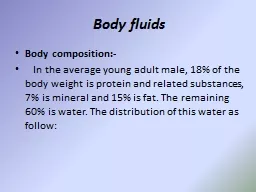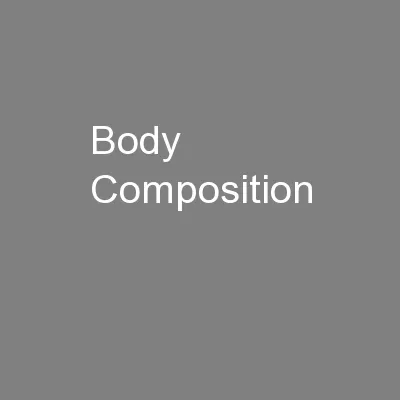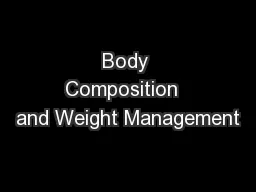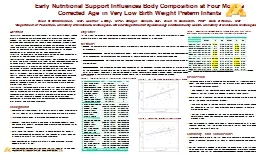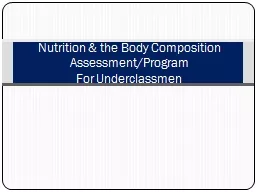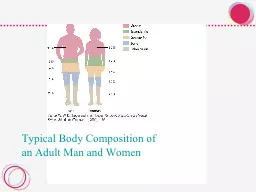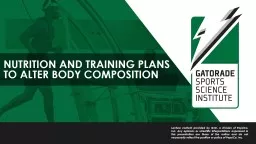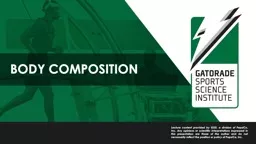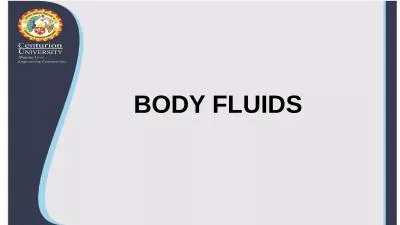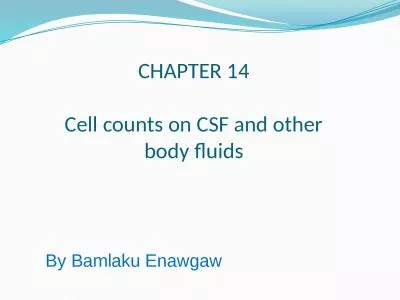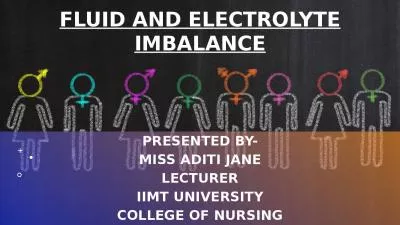PPT-Body fluids Body composition:-
Author : grewhypo | Published Date : 2020-06-13
In the average young adult male 18 of the body weight is protein and related substances 7 is mineral and 15 is fat The remaining 60 is water The distribution of
Presentation Embed Code
Download Presentation
Download Presentation The PPT/PDF document "Body fluids Body composition:-" is the property of its rightful owner. Permission is granted to download and print the materials on this website for personal, non-commercial use only, and to display it on your personal computer provided you do not modify the materials and that you retain all copyright notices contained in the materials. By downloading content from our website, you accept the terms of this agreement.
Body fluids Body composition:-: Transcript
In the average young adult male 18 of the body weight is protein and related substances 7 is mineral and 15 is fat The remaining 60 is water The distribution of this water as follow The intracellular component of the body water accounts for about 40 of body weight and the extracellular component for about 20 Approximately 25 of the extracellular components is in the vascular system plasma 5 of body weight And 75 out side the blood vessels interstitial fluid 15 of body weight the total blood volume is about 8 of body weight. associated network marketing efforts. Our ience based pH testing methods balanced pH.n of the pH of foods goes back at least 100 years.As the pH idea became more popular, I noticed that many marketers Health Zones For Body Fat. Males 7-23%. Females 11-33%. Body composition. Muscle. Water. Bone. Fat. Body . composition is the ratio of these four things. Calories in and Calories out. There are . 3500 calories . Chapter 9. Do Now- Intro to Body Comp.. Tell me anything that comes to mind when you Hear the words Body Composition. . If you wanted to lower your Body Composition tell me one thing you could change about your diet today and stick with.. Identify what your ideal body weight is. Be able to calculate Body Mass Index as well as determine if you are overweight or obese.. Employ safe methods of weight loss as well as understand unhealthy weight gain and weight loss. Learning outcomes. Discuss the basic physiological concepts related to body composition. Compare and contrast laboratory and field methods to determine and interpret body composition. Discuss physiologic, environmental and behavioral factors that influence weight control. at . Four Months . Corrected . Age . in . Very Low Birth Weight Preterm . Infants. Ellen . C Christiansen, MD. 1. , Heather L Gray, MPH. 1. , Bridget . Davern. , BA. 1. , Ellen W . Demerath. , . PhD. For Underclassmen. Learning Topics. Definition of nutrition. 14 steps to eat healthy. Eating a healthy breakfast. Things to avoid. Body composition. How to measure body composition. How to improve body composition. an Adult Man and Women. Body Composition Assessment. Body Mass . Index. Waist Size. Bioelectrical . Impedance. Waist-to-Hip. Ratio. Skinfold Fat. Measurement. The Bod Pod. Dual X-ray . Absorptiometry. Lecture content provided by GSSI, a division of PepsiCo, Inc. Any opinions or scientific interpretations expressed in this presentation are those of the author and do not necessarily reflect the position or policy of PepsiCo, Inc.. Do Now. Write down anything that comes to mind when you think of body composition. What do you think are some criteria for a positive body composition?. If you went to the doctor today and they told you that you needed to lower your body composition, what 3 realistic changes could you make?. OVERVIEW. Body Composition Concepts. . Methods of Assessing Body Composition. Body Composition Classifications. Practical Applications for Athletes. BODY COMPOSITION CONCEPTS. The body’s relative amounts of fat and lean body tissue (or fat-free mass – FFM). lean. - . 70% of Body wt. is water. Fatty animals – Less body Water – As low As 40%. TOTAL BODY WATER. Body water content influenced by. Species. Food habits. Age. Nutritional status. Environment. By Bamlaku Enawgaw. Objectives. At the end of this chapter, students will be able to:. Define terms related to body fluids. Identify different types of body fluids. Define CSF. Define Serous fluids: pleural, pericardial, peritoneal (. LECTURER. IIMT UNIVERSITY. COLLEGE OF NURSING. FLUID AND ELECTROLYTE IMBALANCE. Body fluids are distributed in two distinct area-. Intracellular flui9d (ICF) 40% body weight. Extracellular fluid (ECF) 20% body weight.
Download Document
Here is the link to download the presentation.
"Body fluids Body composition:-"The content belongs to its owner. You may download and print it for personal use, without modification, and keep all copyright notices. By downloading, you agree to these terms.
Related Documents

